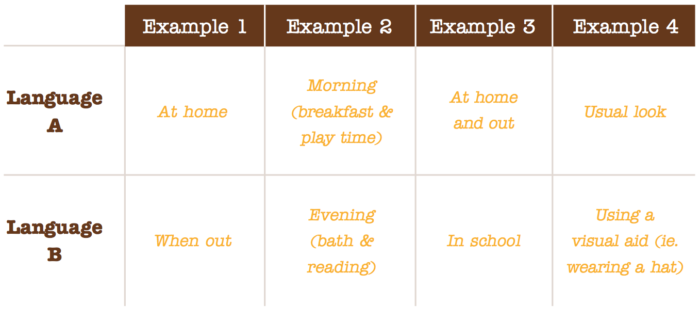In my previous post, I wrote about being told that I could only speak one language to my son Leo otherwise it would confuse him. This was something I did not want to believe as I really wanted him to speak both Mandarin and Portuguese. This motivated me to find researches and books about multilingualism and learn about strategies on how to make it work.
From the books and articles I read and people I have spoken to, there are many ways to raise a trilingual child.
- A family using the OPOL approach living in a foreign country (example A).
- A family speaking a minority language at home, with the caregiver or grandparents speaking another minority language whilst the school and community speaks a third language (example B).
- A less common scenario is having one of the parents speak two languages while the other speaks a third language which can be the community language or not (example C). See table below.
Examples of families raising trilingual children
| Community language | Parent 1 | Parent 2 | Caregiver | |
| Example A | English | Portuguese | Mandarin | N/A |
| Example B | English | Spanish | Spanish | French |
| Example C | English | English | Portuguese & Mandarin | English |
One parent, two languages
So how can one parent speak two languages without confusing the child and making sure there is consistency in the approach?
There are a few ways you can do this. With the time and location approach, you can set a time and/or location for each language. See below examples:
- For example, you will always speak language A at home and language B when outside the house.
- Or you can speak language A during the day and switch to language B when doing certain activities, like bath time or reading time.
- Or you can speak language A in the lounge and language B whenever in the bedroom.
- Another example is to clearly demarcate the change in language through something visual, like wearing a hat or putting up a flag on the wall. These strategies help your child understand that you are now changing the language.
Ways to introduce the one parent two languages approach

While these are some inspirations for you to get started, they are by no means exhaustive, the possibilities are endless and only limited to your imagination. But once you have decided on the approach, try to be consistent. If you need to make changes to fit your needs, by all means, but avoid changing it back and forth as this will end up confusing your child and yourself.
Is it too late now?
Some of you might be wondering, I started speaking one language because I did not want to confuse my child, is it too late to introduce another language now? What if my child refuses to speak to me because she does not understand me?
While it is ideal to start as early as possible, it is possible to introduce another language at a later stage, I believe it is never too late, after all, we are able to learn a new language even as grown ups! Though usually not quite at native level. But you will have to take one step at a time and be kind to yourself and your child.
One strategy is to introduce songs and reading books in the “new” language you want to introduce. Music is one of the best ways to get your child acquainted to the new language as they might not even realize that the song is in another language.
Young children love picture books, they will be looking at the pictures while you read the story to them. If you have the option of hiring a person to help introduce the new language it can also be very helpful as children learn best through interactions in person (although this method might have some drawback if the person is suddenly not available to come anymore).
Another strategy I read about was introducing a puppet that only speaks the new language – I thought this method is fun and easy to implement as the child can make an easy connection between the puppet and the language. Lastly, you can play their favorite cartoons in the new language.
Ways to introduce a new language
- Nursery rhymes and songs
- Picture books
- Nanny/au pair
- Cartoons
- A puppet that only speaks the target language
What is your strategy to expose your child to two or more languages? Leave a comment down below to let me know!


